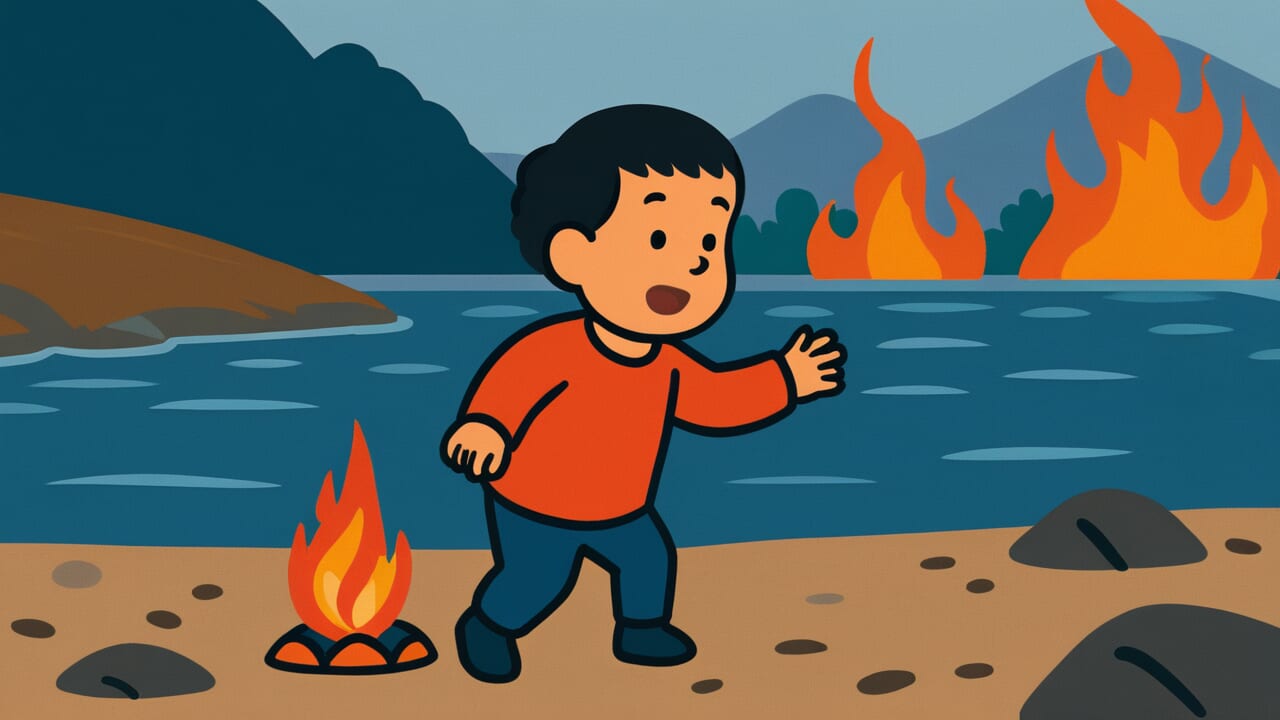How to Read “Children, riverside, beware of fire”
Kodomo kawabata hi no yōjin
Meaning of “Children, riverside, beware of fire”
This proverb means it’s important to teach children carefulness and good habits from a young age, just as you would teach them to be careful around fire.
Teaching children about fire dangers early doesn’t just prevent fires. It helps develop a careful attitude toward everything in life.
People use this proverb when talking about the importance of early education and habit formation. For example, you might use it when someone thinks their child is too young to learn basic manners or safety rules.
You’re telling them that young children are exactly the right age to start teaching these things.
This idea remains very important today for children’s safety education and developing good life habits. Habits learned in early childhood become lifelong treasures.
Carefulness and caution help in every situation throughout life. It’s never too early to start teaching children.
In fact, early teaching protects their future. This proverb expresses the true essence of education.
Origin and Etymology
No clear written records explain the origin of this proverb. However, we can make interesting observations from how the words are structured.
Notice the three elements: “children,” “riverside,” and “beware of fire.” In Edo period Japan, rivers and fire represented the most common dangers children faced.
Drowning accidents in rivers and damage from fires were constant threats in people’s daily lives.
Riversides were popular play areas for children, but they were also dangerous places. Fire was equally frightening in Edo towns where wooden houses stood close together.
One fire could quickly become a disaster. There’s even a saying that “fires and fights are the flowers of Edo,” showing how common fires were.
This proverb uses these specific dangers as examples. It teaches the importance of helping children develop carefulness and good habits from an early age.
The meaning goes deeper than just warning about rivers and fire. It’s the wisdom of ancestors who used familiar, urgent examples to express broader life lessons.
They turned everyday dangers into teaching materials to convey wider truths about life.
Usage Examples
- Teaching my grandchild greetings while they’re still small is truly “Children, riverside, beware of fire”
- As they say, “Children, riverside, beware of fire,” so let’s teach traffic rules thoroughly from an early age
Universal Wisdom
The proverb “Children, riverside, beware of fire” contains deep insights about human growth and learning. Why did our ancestors place such importance on early childhood education?
They knew from experience that the foundation of human habits and values forms surprisingly early. Young minds are flexible and absorb both good and bad things naturally.
What children learn during this time becomes “second nature.” These lessons appear naturally in their actions without conscious thought.
This proverb also reveals the true nature of protective love. Teaching children caution and habits isn’t just forcing rules on them.
It’s giving them the power to protect themselves from future dangers and difficulties. Children who don’t know fire’s dangers get burned.
Children who don’t understand river dangers can drown. Knowledge and habits become invisible armor that protects a person throughout life.
Looking deeper, this proverb teaches wisdom about investing time. It shows that “small efforts today lead to great safety tomorrow.”
People tend to focus on immediate concerns. But looking at the long term, early education is the most efficient and reliable method.
Our ancestors understood how crucial the first steps are on life’s long journey.
When AI Hears This
This proverb brilliantly expresses the modern safety theory of “multiplying” risk factors. Children alone just means strong curiosity.
Riverside alone just means water is present. Fire alone is simply a household tool. None of these is deadly by itself.
But when all three combine, probability multiplies exponentially. If each element carries 10 percent risk, simple addition gives 30 percent.
But in reality, these independent events combine differently. The accident possibility increases exponentially.
Heinrich’s Law shows the “1 to 29 to 300” ratio. Its essence is that accumulated small danger factors create major accidents.
What’s interesting about this proverb is how it lists three elements in parallel. This subtly shows that removing any one element breaks the chain.
To prevent fire, you can keep children away, avoid the riverside, or manage fire carefully. Doing any one of these works.
This is exactly the “defense in depth” concept in modern safety engineering.
Even more noteworthy is that the proverb emphasizes “beware of fire” rather than “fire breaks out.” It stresses prevention.
The message is to intervene before major accidents happen, at the 300 near-miss level in Heinrich’s terms.
Edo period people understood risk structure through experience alone, without statistical data.
Lessons for Today
This proverb teaches modern people the courage that “it’s never too early to start.” When we try to learn something new or teach children or juniors, we often postpone things.
We say “it’s too early” or “wait until they’re more mature.”
But truly important things are worth teaching early. They become not just knowledge but attitudes and habits that form the foundation of a person’s life.
Teaching small children polite language, developing safety awareness, and conveying compassion are never wasted efforts.
This proverb also offers a lesson for ourselves. If you want to develop new habits, start today.
Healthy lifestyle habits, learning habits, ways of relating to people—people can change at any age. But the earlier you start, the more natural it becomes.
These habits will protect and support you. What matters isn’t waiting for perfection. It’s having the courage to start with what you can do now.



Comments